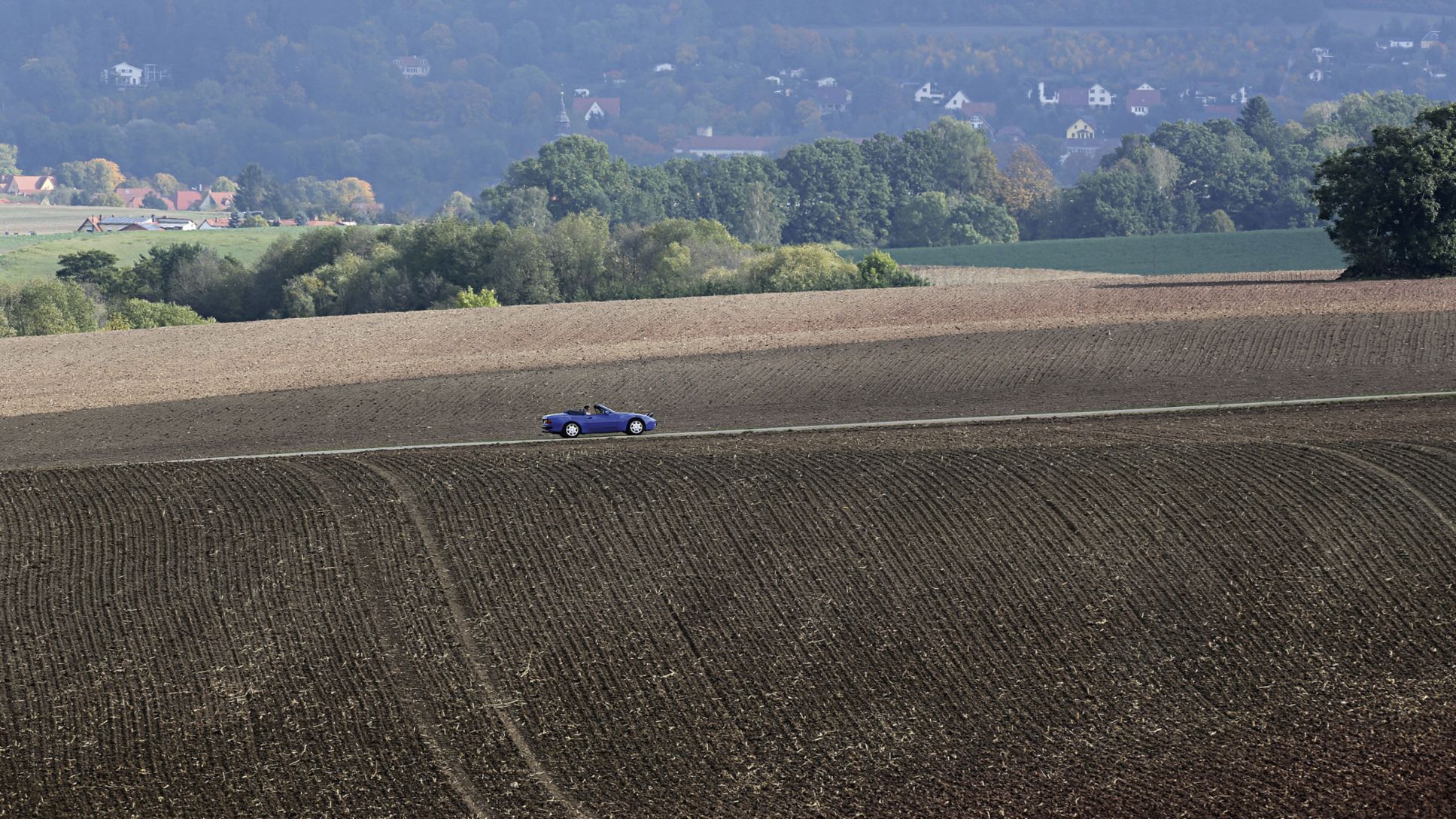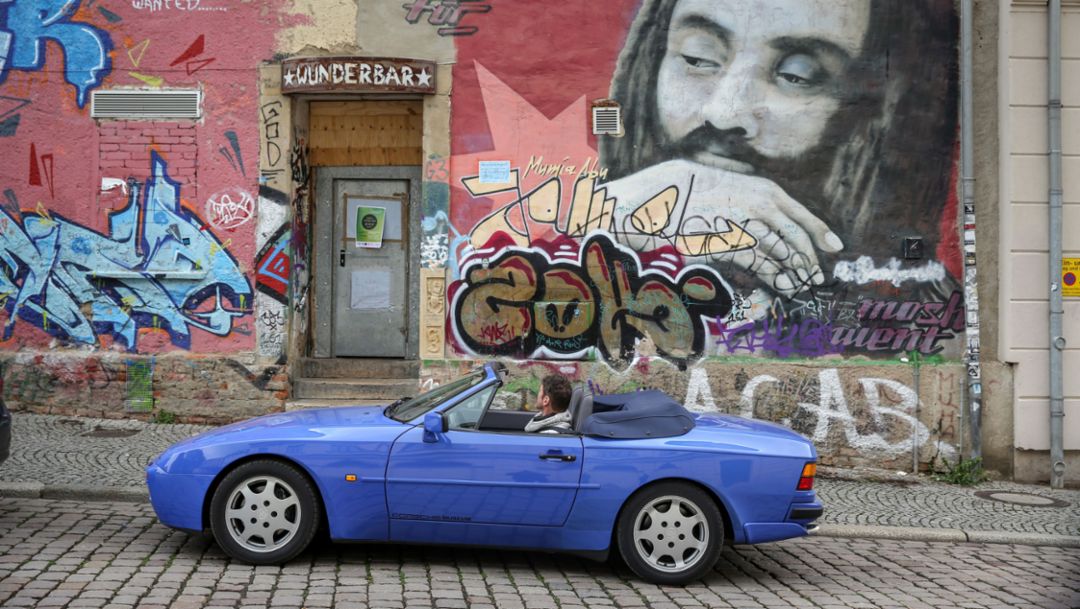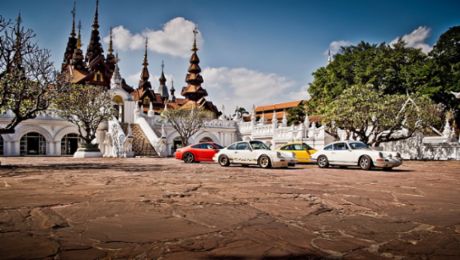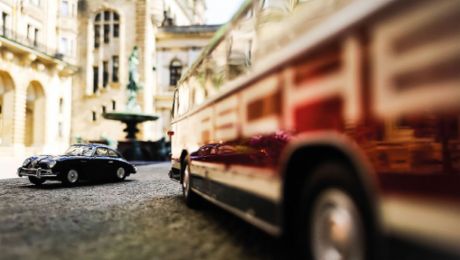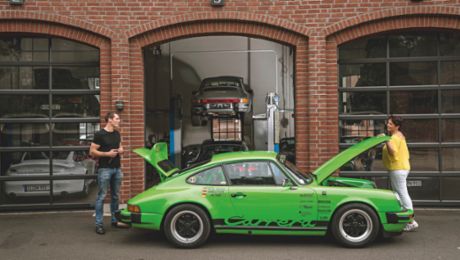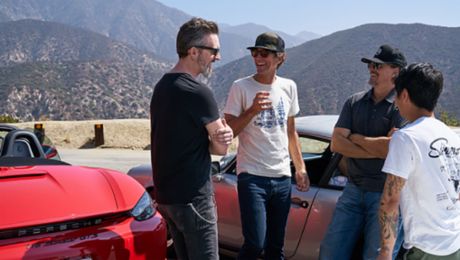“Sturm und Drang” was a period of German literature that Goethe and Schiller had already put behind them when they eventually met and became close friends in Weimar. It was a period dominated by ideas such as an absolute yearning for freedom, emotion over reason and a rejection of regulatory constraints, and typified the earlier work of both authors. In Weimar, where Goethe settled in 1775 as a minister of the young Duke Karl August, the poet laureate emerged from the unrest of his Sturm und Drang era into the peace and order of classicism. Around 20 years later, the city – an important administrative centre – also signalled the end of a long odyssey for Goethe’s younger counterpart Friedrich Schiller.
“Sturm und Drang” would also be a fitting way to characterise the sudden appearance of the Porsche 944 Turbo Cabriolet in Thuringia. The 944 is an open top 250 hp sports car that remains as popular a quarter-century after its launch as it ever was. “Sturm” should not be construed as a reference to headwind; with this car, even at high speed and with the top down, the air skims over the top of the head. Both “Sturm” and “Drang” are more relevant to the 2.5 litre turbo drive, which storms into life after a brief intake of air and forces the low cabriolet into motion.
Safely navigated by the 1.4-tonne cabriolet
The roads between the picturesque Weimar and the neighbouring state capital of Erfurt form the perfect backdrop for this classic car. Many of the country roads follow the natural lay of the land just like the original roads built for carriages during the Baroque era. These roads have not been levelled out; no lanes have been cut into the rolling landscape, unlike the fast highways built after the fall of the Berlin Wall. The trajectory alternates between sloping corners, dips and short straights; time and again, the road slopes upwards immediately after a bend. But these challenges are welcomed: To master them, the driver needs to use a low gear, plenty of gas, and push the car up to 4,000 rpm; the purring sound of the large four-cylinder engine belying its true power. The hills, which often culminate in a blind summit, are safely navigated by the 1.4-tonne cabriolet which – thanks to its perfect weight distribution courtesy of the transaxle – remains perfectly balanced. It’s a refreshing change to drive on roads that are barely ever straight or level...
However, the 944 Turbo Cabriolet has to admit defeat (as any other car would) at Erfurt old town. The countless picturesque alleyways have remained virtually unchanged since the era of German classicism, and are neither wider nor more level than they were at the time of their construction. The uneven cobblestones, although aesthetically pleasing, can typically only be tackled at walking pace – but the best way to explore Erfurt is on foot anyway. The city earned its riches as a meeting point between two major trading routes and as an exporter of woad, a blue dye. Its universities gained a worldwide reputation, and Erfurt was an important seat of government until the 19th century. A stroll through the town is like flicking through an architectural picture book: medieval churches meet small workshops, decorative Renaissance façades and lavish art nouveau buildings.
One of Europe's most fascinating old town squares
Anger – the commercial heart of Erfurt, with trams running in all directions – is a popular meeting point. Buildings spanning nine centuries, including the magnificent post office and ornamental Anger Entrée, line the square. From here, you can walk along Schlösserstraße to the fish market, which is one of Europe's most fascinating old town squares, featuring monumental buildings from different eras. Past the neo-gothic town hall, the road leads to the city’s sightseeing highlight: the Krämerbrücke, or merchant’s bridge. As early as the 12th century, merchants hawked their sought-after wares, such as spices, precious metals and dyes, on the wooden predecessor to today’s structure. Today, the unique bridge – the only one of its kind in the world to be fully lined with buildings – is home to 32 specialist workshops. All but two of these buildings belong to the city of Erfurt. Local entrepreneurs with unusual business ideas are given priority for property leases. Behind the door of each of the shops lies a fascinating miniature world: A left-handed shop, a jewellery design studio, a gallery, ceramics, antiques, a bookshop, a delicatessen, a chocolate maker and a store selling local Thuringia produce are among the businesses lining the bridge.
The bridge’s unique charm also radiates from the brightly coloured statues of mice, elephants, bears and even a slice of bread that may await on any corner – as well as the sandman inviting you to take a nap on a bench. All of these figures are characters from the children’s television channel KiKA, which is based in Erfurt. The historic old town also gets its distinctly youthful feel from the presence of students, groups enjoying a night out and young tourists attracted to organic cafés and vegan snack bars. The coffee and cakes at Clara Grün Café are made exclusively from fair-trade products and come highly recommended. Customers can enjoy their purchases on the lawn at the Predigerkirche church just opposite the café.
The 1991 944 Turbo Cabriolet is an ultra-rare collector’s piece
Another top tip – this time less of a secret and more of a must-do for any visitor – is a trip to Erfurt Cathedral. The majestic building sits atop the 70 wide steps of the Domberg. During the day, the site is swarming with tourists. So the best time to get peace and quiet for a photoshoot with the Porsche 944 Turbo Cabriolet would be the evening – you’d think. A group of students passes by; many turn around and point at the blue cabriolet, an indication of its timeless design. They recognise the 944 not as a modern car, but as the very essence of the sports car: flat and wide, with a long bonnet. And it‘s a cabriolet to boot – nice. In no time, the Porsche is surrounded in the cathedral square; a young woman asks the photographer to take a picture of her and her partner with the Porsche on her mobile phone.
The car’s admirers probably don’t even know how rare the car that they’re looking at actually is. One of just 528 ever built, this 1991 944 Turbo Cabriolet is an ultra-rare collector’s piece. And with a top speed of 260 km/h, it is probably the fastest open top four-cylinder car in the world.
The engine was derived from the right cylinder block from the V8 engine in the Porsche 928, and increased in capacity to 2.5 litres. Balancing shafts rotating at double crankshaft speed result in a low level of running noise similar to that of a six-cylinder engine. The initial 163 hp (without catalytic converter) drive was boosted to 190 hp in 1986 in the 944 S thanks to four-valve technology. The 3.0 litre version of the 944 S2 was increased to 211 hp in 1988. A year later, the 944 S2 Cabriolet made its début with this DOHC engine.
The style of the cabriolet with the technology and finish of its most powerful turbo model
Meanwhile, the twin-valve engine returned to glory thanks to turbocharging. The 250 hp version came from the Porsche 944 Turbo Cup engine, and was first added to the 944 Turbo S Coupé in 1988. As the crowning glory on the model line, Porsche transformed the style of the cabriolet by adding the technology and finish of its most powerful turbo model in 1991, creating a special series that was produced for just a few months. Air conditioning and an electric hood were standard equipment. With a retail price of 103,725 marks, the 944 Turbo Cabriolet was the only 944 with a six-figure price tag.
The cabriolet features one little detail especially for those who enjoy the feel of solid mechanics: Although the hood opens and closes electrically, the first and final step must be completed manually; the hood is released and secured using a steel catch. The catch is inserted into the two recesses on the windscreen frame. After a quarter-turn, the hood edge is drawn securely towards the frame and engages with a reassuring click. Another nice detail: The traditional square wrenches are stored symmetrically in the centre console. The windscreen is around six centimetres flatter and more tilted than the coupé version, to minimise wind noise when driving with the top down.
Weimar: diverse cultural activity, modern street art
Weimar is even more of a tourist magnet than the state capital of Erfurt. With its cobbled roads and tracks for horse-drawn carriages, baroque buildings and people strolling around the old town, the city is picturesque – but never boring. Despite its small size, Weimar is brimming with diverse cultural activity, making room for modern street art and establishments like WunderBar on Gerberstraße – a space dedicated to art, diversity and subculture – without losing its classical roots.
It is highly likely that it was precisely this combination of personal freedom and peace that attracted Johann Wolfgang von Goethe, followed by Friedrich Schiller in 1799. Today, their statues are raised on a pedestal, arm in arm, looking out over Theaterplatz – but the pair did not get on when they first met in 1788. Goethe felt threatened by the growing fame of his ten-year younger counterpart, while Schiller found Goethe arrogant. Only when they visited Goethe’s adopted home of Weimar did the poets get to know – and like – one another.
Goethe’s home on Frauenplan now houses the national Goethe museum
Goethe’s home on Frauenplan, a welcoming and homely square in the south of the old town, now houses the national Goethe museum, where visitors can find out more about the poet who resided here for almost 50 years, while learning about the era in which he lived and the microcosm of Weimar. Schiller later moved in virtually around the corner, choosing a house on a tree lined with sycamores, now known as Schillerstraße.
Take a stroll down this street and you will soon encounter the joint monument to the pair of thinkers, looking towards the future, with their gaze fixed on the Bauhaus museum. For this represents another side to Weimar – the original breeding ground of the movement that dispensed with ornamentation and advocated the dominance of function over form. In 1925, Bauhaus relocated to Dessau for political reasons, and only one building has ever been built in Weimar in true Bauhaus style: the Haus Am Horn. At the time of its construction, the site – on a hillside just north of Goethe’s summer house in Ilmpark – was earmarked for the development of an entire Bauhaus residential estate. Around the new millennium, the idea was brought back to life and turned into reality as the "New Living Weimar" project.
Today, skateboarders fearlessly practice their tricks at the base of the poet monument on Theaterplatz. The statues gaze approvingly across the goings-on of modern society below – after all, they once represented a youth revolution in the quest for an unconventional, self-determined life. And as Schiller himself said: “Man only plays when in the full meaning of the word he is a man, and he is only completely a man when he plays”.
Technical data
Porsche 944 Turbo Cabriolet
Engine: R4 cylinder front engine (water-cooled) with two valves per cylinder and an overhead camshaft (SOHC), KKK turbocharger, Bosch-L-Jetronic
Displacement: 2,479 cm3
Bore x stroke: 100 mm x 78.9 mm
Max. power: 250 hp/184 kW at 6,000 rpm
Max. torque: 350 Nm at 4,000 rpm
Power transmission: Rear-wheel drive, transaxle principle, 40 per cent differential lock
Transmission: 5-speed manual transmission
Unladen weight: 1,400 kg
Front tyres: 225/60 ZR 16, rims 7J x 16
Rear tyres: 245/45 ZR 16, rims 9J x 16
Vmax: 260 km/h
0–100 km/h: 5.9 s
Units built: 528
New price: 1991 103,725 DM
Info
Text first published in the magazine "Porsche Klassik 11".
Text by Johannes Schnettler // Photos by Stephan Lindloff
Copyright: The image and sound published here is copyright by Dr. Ing. h.c. F. Porsche AG, Germany or other individuals. It is not to be reproduced wholly or in part without prior written permission of Dr. Ing. h.c. F. Porsche AG. Please contact newsroom@porsche.com for further information.
